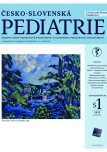Tick-borne infections in the conditions of the Czech Republic
Authors:
Blechová Zuzana; Smíšková Dita
Authors‘ workplace:
Klinika infekčních, parazitárních a tropických nemocí, Fakultní nemocnice Bulovka, Praha
; Klinika infekčních nemocí 2. lékařské fakulty Univerzity Karlovy a Fakultní nemocnice Bulovka, Praha
Published in:
Čes-slov Pediat 2022; 77 (Supplementum 1): 13-18.
Category:
Review
doi:
https://doi.org/10.55095/CSPediatrie2022/024
Overview
Ticks are a vector and often a reservoir of viral and bacterial diseases. A person usually gets infected after the infestation of an infected tick or its developmental stage as a random link in its life cycle. Due to the geographical conditions in the Czech Republic, these diseases have a epidemiological significance and impact on morbidity. The communication subject describes infections, their epidemiology, clinical picture, and diagnostics, focusing on the specifics of childhood in our conditions. The subject of a separate communication is Lyme borreliosis, the most common of these presented diseases.
Keywords:
diagnosis – tularemia – Ticks – Tick-borne encephalitis – Babesiosis – childhood – treatment – ehrlichiosis
Sources
- Orlíková H, Lenz O, Vlčková I, Kynčl J. Klíšťová encefalitida v České republice v roce 2020. Zprávy CEM (SZÚ Praha) 2021; 30: 7–8.
- Daniel M, Danielová V, Kříž B, et al. The occurrence of Ixodes ricinus ticks and important tick-borne pathogens in areas with high tick-borne encephalitis prevalence in different altitudinal levels of the Czech Republic Part I. Ixodes ricinus ticks and tick-borne encephalitis virus. Epidemiol Mikrobiol Imunol. 2016; 65(2): 118–128.
- Kerlik J, Avdičová M. Pravdepodobný prenos vírusu kliešťovej encefalitídy materským mliekom u dojčaťa. Pediatria (Bratisl.) 2020; 15(5): 321–323.
- Lipowski D, Popiel M, Perlejewski K, et al. A cluster of fatal tick-borne encephalitis virus infection in organ transplant setting. J Infect Dis. 2017; 215(6): 896–901.
- Kaiser R. Frühsommermeningoenzephalitis. Nervenarzt 2016; 87: 667– 680. doi: 10.1007/s00115-016-0134-9
- Klaus C, Beer M, Saier R, et al. Goats and sheep as sentinels for tick-borne encephalitis (TBE) virus – epidemiological studies in areas endemic and non-endemic for TBE virus in Germany. Ticks Tick Borne Dis 2012; (3): 27–37.
- Jones N, Sperl W, Koch J, et al. Tick-borne encephalitis in a 17-day-old newborn resulting in severe neurologic impairment. Pediatr Infect Dis J 2007; (26): 185–186.
- Hansson ME. et al. Tick-borne encephalitis in childhood: rare or missed? Pediatr Infect Dis J 2011; 30(4): 355–357.
- Rostasy K. Tick-borne encephalitis in children. Wien Med Wochenschr 2012; 162: 244–247. doi: 10.1007/s10354-012-0101-4
- Lesnicar G, Poljak M, Seme K, Lesnicar J. Pediatrictick-borneencephalitis in 371 casesfromanendemic region in Slovenia, 1959–2000. Pediatr Infect Dis J 2003; 22: 612–617.
- Engman ML, Lindström K, Sallamba M, et al. One year follow-up of TBE- -CNS infections in childhood. Pediatr Infect Dis J. 2012; 31: 570–574.
- Labuda M, Elecková E, Licková M, et al. Tick-borne encephalitis virus foci in Slovakia. Int J Med Microbiol 2002; 291(Suppl 33): 43–47.
- Iff T, Meier R, Olah E, et al. Tick-borne meningo-encephalitis in a 6-week- -old infant. Eur J Pediatr 2005; 164(12): 787–788.
- Čermáková H, Forejt M. Klíšťová encefalitida a kojení. Čes-slov Pediat 2021; 76(3): 162–165.
- Polcarová P, Smetana J, Šošovičková R, et al. Klíšťová encefalitida – epidemiologie a současné možnosti očkování. Vakcinologie 2017; 11(3): 118– 125.
- Dobler G, Erber W, Bröker M, Schmitt HJ (eds.). The TBE Book (3rd edition). Singapore: Global Health Press Pte Ltd. 2020.
- Fowler A, Stodberg T, Eriksoon M, Wickstrom R. Long-term outocomes of acute encephalitis in childhood. Pediatrics 2010; 126: e829–835.
- Smíšková D. Klíšťová meningoencefalitida – klinické projevy a následky. Vakcinologie 2017; 11(3): 126–129.
- Palyga-Bysiecka I, Kręcisz B, Szczepańska B. Clinical course and neurological sequels after tick-borne encephalitis in children – case report. Ann Agric Environ Med 2022; 29(1): 162–167. doi: 10.26444/aaem/133206
- Krbková L, Štroblová H, Bednářová J. Clinical course and sequelae for tick- -borne encephalitis among children in South Moravia (Czech Republic). Eur J Pediatr 2015; 174(4): 449–458.
- Hromníková D, Furka D, Furka S, et al. Prevention of tick-borne diseases: challenge to recent medicine. Biologia 2022. doi: 10.1007/s11756-021- 00966-9
- Penn RL. Francisella tularensis (tularemia). In: Mandell GL, Bennett JE, Dolin R (eds.). Mandell, Douglas and Bennett‘s principles and practice of infectious diseases. 7th ed. Philadelphia (PA ): Elsevier-Churchill Livingstone 2010: 2927–2937.
- Bratton RL, Corey R. Tick-borne disease. Am Fam Physician 2005; 71(12): 2323–2330.
- Tezer H, Ozkaya-Parlakay A, Aykan H, et al. Tularemia in children, Turkey, September 2009–November 2012. Emerg Infect Dis. 2015; 21: 1–7.
- Imbimbo C, Karrer U, Wittwer M, Buettcher M. Tularemia in children and adolescents. Pediatr Infect Dis J 2020; 39(12): e435–e438. doi: 10.1097/ INF.0000000000002932
- Karataş Yeni D, Büyük F, Ashraf A, et al. Tularemia: A re-emerging tick- -borne infectious disease. Folia Microbiol (Praha) 2021; 66: 1–14. doi: 10.1007/s12223-020-00827-z
- Maurin M, Gyuranecz M. Tularaemia: Clinical aspects in Europe. Lancet Infect Dis 2016; 16: 113–124. doi: 10.1016/S1473-3099(15)00355-2
- Kubelkova K, Macela A. Francisella and antibodies. Microorganisms 2021; 9(10): 2136. doi: 10.3390/microorganisms9102136
- Beneš J. Infekční lékařství. Praha: Galén 2009.
- Balátová P, Berenová D, Kodym P. Anaplasma phagocytophilum jako původce humánní granulocytární ehrlichiózy (HGA). Zprávy CEM (SZÚ, Praha) 2013; 22(2): 61–63.
- Rieg S, Schmoldt S, Theilacker C, et al. Tick-borne lymphadenopathy (TIBOLA) acquired in Southwestern Germany. BMC Infect Dis 2011; 11: 167.
- Hrazdilová K, Lesiczka PM, Bardoň J, et al. Wild boar as a potential reservoir of zoonotic tick-borne pathogens. Ticks Tick Borne Dis 2021; 12(1): 101558. doi: 10.1016/j.ttbdis.2020.101558
Labels
Neonatology Paediatrics General practitioner for children and adolescentsArticle was published in
Czech-Slovak Pediatrics

2022 Issue Supplementum 1
- What Effect Can Be Expected from Limosilactobacillus reuteri in Mucositis and Peri-Implantitis?
- The Importance of Limosilactobacillus reuteri in Administration to Diabetics with Gingivitis
Most read in this issue
- Summer-associated dermatitides in children
- Tick-borne encephalitis in Slovakia – epidemiology and history
- Tick-borne infections in the conditions of the Czech Republic
- Drowning
